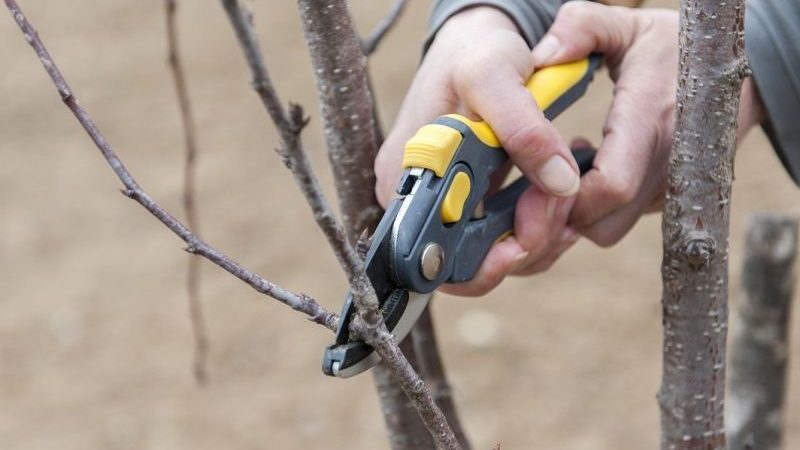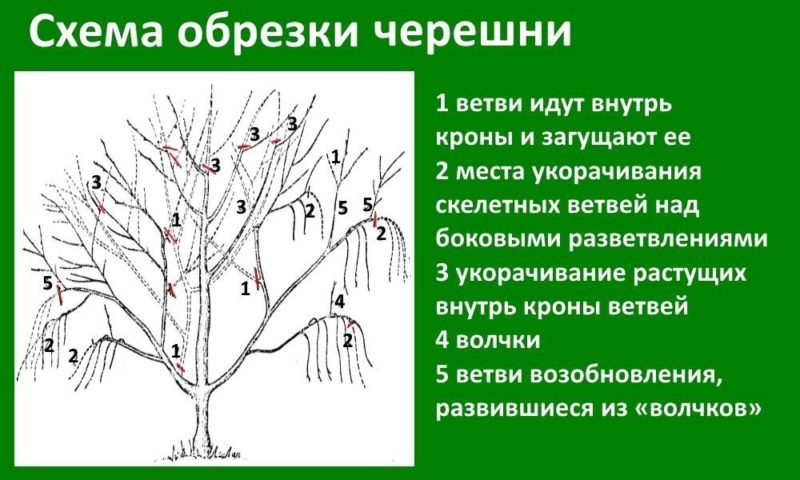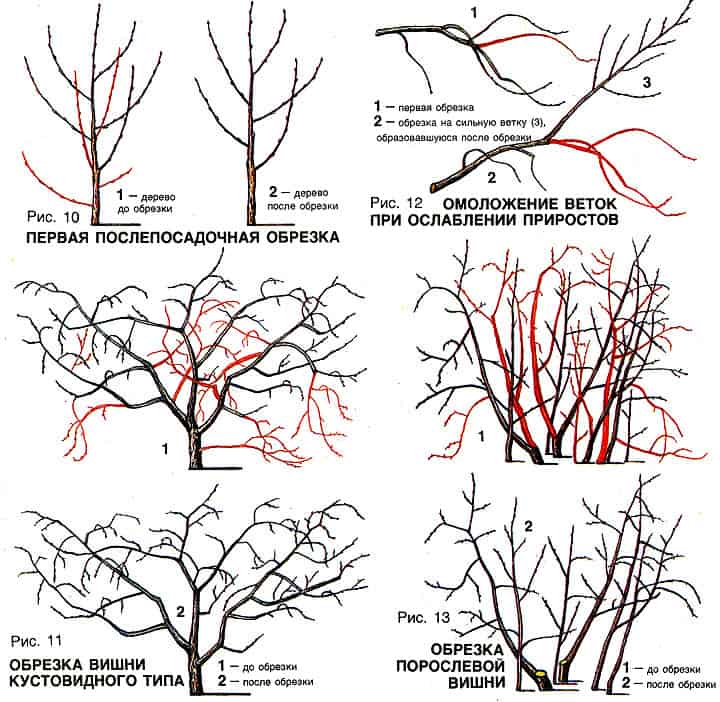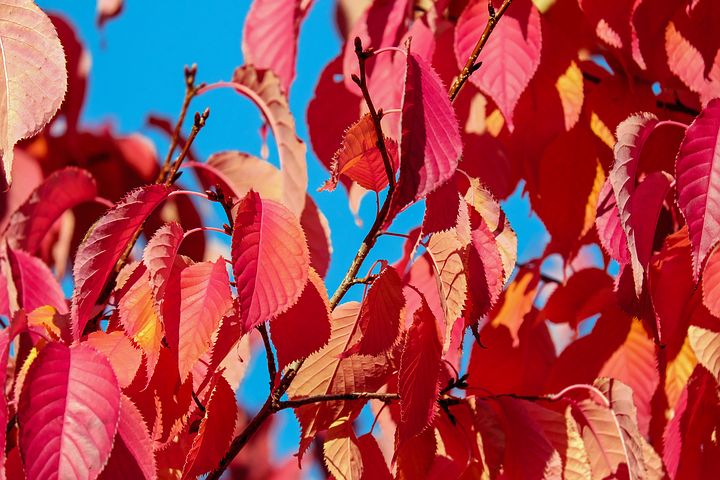When to prune cherries in the fall and how to do it right
Cherry is a fast growing fruit tree that requires constant maintenance. One of the obligatory agrotechnical procedures is pruning. It increases yields and extends the life of the plant. The event is not easy, therefore it requires a thorough study of the issue and adherence to the recommendations of experienced summer residents. In the article, we will consider in detail how to update and rejuvenate garden cherries and what is required for this.
The content of the article
Why prune cherries in the fall

Autumn pruning heals the plant. In the process, all diseased and old branches and dry leaves are removed. Regular pruning increases the lifespan of the cherry tree, increases the quantity and quality of the harvest. In addition, the procedure protects the plant from pests and diseases that appear on neglected trees.
If you do not cut the cherries in the fall, there is a high risk that the tree will wake up weakened next spring - old branches take up most of the nutrients. All this leads to a decrease in yield.
Attention! If gardeners know in advance that they will not be able to cut the cherry in the fall, they carry out the procedure at the end of August. By this time, the tree has already yielded a harvest and is preparing for the upcoming winter.
Types of trimming
Distinguish between forming, rejuvenating, regulating pruning. Each of them has specific goals and characteristics.
Formative
Formative pruning is carried out in both autumn and spring. The purpose of the procedure is to give the crown of the tree a well-groomed and neat shape and to prevent the appearance of diseases and insect pests.
If the plant is medium-sized and grows in a small area, the crown is given a bushy shape; if it is high, and there is room for growth, it is tree-like. Forming starts from the first year after landing.
Formative pruning rules:
- Gardeners recommend shortening the skeletal shoots of the second row so that they are the same in length.
- Next, remove all shoots that grow inside the crown and from the trunk at an acute angle.
- In the last turn, cut off annual branches longer than 50 cm. It is necessary to make sure that all cherry shoots are approximately the same length. This cherry looks well-groomed and has a high yield.
Regulatory
Regulatory pruning brightens the cherry crown and prepares the shoots for the coming winter. It is used already on formed trees from the age of 2-3 years.
Also, the regulating pruning maintains the result obtained during the shaping procedure. Otherwise, the branches grow again in a chaotic manner, due to which the crown loses its grooming, and the yield decreases. During the procedure, summer residents remove old and dried branches and shorten the fruiting shoots by 10-20 cm.
Attention! It is believed that regulating pruning only weakens the plant and a shaping procedure is sufficient for cherries. This is not the case because all types of procedures complement each other. Problems arise only if the pruning was not done according to the rules or the crop was not looked after.
Anti-aging
Rejuvenating pruning is carried out on old trees or trees that have stopped bearing fruit. This is done only if the annual growth of branches is no more than 15 cm.
The procedure takes a lot of energy from the cherry, therefore, the tree is first fed with complex mineral fertilizers, for example, "Zdraven" or "Gumi-Omi". They nourish the soil, give the plant strength for further growth and development, strengthen its immunity.
In the process, gardeners cut 90% of the total number of branches from the tree. Shoots are removed to the very trunk, so that new fruiting skeletal branches will grow from them in a year. Also, in the process of rejuvenating pruning, all diseased and damaged branches are removed.
It is not recommended to leave hemp on the tree, this can cause the tree to freeze in winter.
Timing of pruning
Autumn pruning is carried out before the first frost - this is the main condition. In the south of the country it is the end of October, in central Russia - the end of September, in the north - the beginning of September.
The month and day are chosen individually, depending on the weather conditions. The average daily temperature must be at least -5 ° C, otherwise pruning will cause severe stress on the plant. Also, on the day of the event, there should be no gusty winds, rain or other precipitation.
How to properly prune cherries in the fall
Pruning is a difficult agronomic procedure with its own characteristics and secrets.
Before the event, gardeners prepare the necessary equipment and study pruning schemes.
Required materials and tools
The main tool is a sharply sharpened secateurs. It is suitable for young branches or shoots, does not leave torn cuts, which serve as a breeding ground for fungi and bacteria.
If the cherry is old and rejuvenating pruning is done, use a saw. Before use, all garden tools are disinfected with a weak solution of potassium permanganate.
And also summer residents prepare:
- lopper - for working in hard-to-reach places, for example, when branches are intertwined;
- garden shears with a non-slip handle - for very thin scions;
- garden gloves;
- garden var - for processing slices after the procedure (it protects cherries from diseases and helps to recover faster).
Autumn pruning schemes

Consider 2 autumn pruning schemes - for young and old trees. In the first case, summer residents begin to form a crown, since the cherry grows quickly and loses its shape:
- thin out young branches to prevent their growth and thickening of the crown;
- shorten all branches that have grown over the last year, leaving 5-6 skeletal;
- pruning shoots that grow at an acute angle from the base of the trunk;
- lubricate the places of cuts with garden pitch.
When pruning old trees, the main task is to remove dry and diseased shoots. It is they who interfere with normal fruiting. If not removed, the tree will die. After that, summer residents remove chaotically growing branches and the lower row of skeletal ones.
If young shoots are visible, it is better to leave them - next year they will turn into fruiting young shoots. It is also not advised to delete too many branches at one time. If the tree is in disrepair, it is better to divide the pruning into several stages.
Attention! If the tree grows quickly, increasing the length of its shoots by 50 cm annually, it is recommended to do with thinning rather than pruning. This will allow you to form a correct and neat crown and increase yields.
Instructions

Regardless of the type of pruning and the age of the tree, experienced gardeners recommend adhering to simple rules:
- do not cut off all the shoots along with the buds;
- start the procedure by removing old skeletal branches - they are the most powerful;
- trim to the base of the branch with black-brown hardened bark;
- for shoots with weak and thin tips, cut 2/3 of the length;
- make the sections oblique, and not at a right angle - this way they heal faster;
- leave new growth;
- completely cut the top branches.
Features of the procedure depending on the region
In the south of the country, pruning is done after the cherry has shed its foliage.This is convenient - the gardener sees all the branches and immediately determines which ones to shorten and which ones to leave on the tree. Thinning is also used in the southern regions. After the procedure, the tree rejuvenates, the crown becomes well-groomed, its one-sidedness or thickening disappears.
Thinning is the removal of unneeded branches entirely. Thanks to it, the air-light regime of the cherry tree is normalized and the growth of young healthy shoots increases. You can thin out cherries at any time before the first frost.
In the middle zone of the country and in the north (in the Urals, in Siberia) the day is chosen in advance - they study the weather forecast and prepare garden tools. Otherwise, due to unpredictable weather, it's easy to miss the perfect time to trim.
Also, before and after the event, fertilize the plant with dressings. They are brought in 2-3 weeks before and 2-5 days after. This is especially true for varietiesthat do not have strong immunity.
Caring for the tree after pruning

After the procedure, the plant needs nutrition and moisture more than ever. It is recommended to sprinkle the base of the tree with a mulch layer. This will protect the roots from freezing. Sawdust, dry grass or foliage, peat are used as mulch. The latter is especially effective - when decomposed, it will enrich the earth with nutrients.
After they pay attention to whitewashing. To prepare the solution, use 1 kg of lime, 1 kg of clay, 0.5 kg of mullein and 300 g of copper sulfate. The components are mixed together and applied to the barrel. Then it is wrapped in natural fabric and garden netting. Thanks to copper sulfate, cherries are protected from fungal spores, and mullein scares away rodents.
It is interesting:
A step-by-step guide to pruning felt cherries in summer for beginners
How to properly water cherries in summer: instructions for beginner gardeners
Conclusion
Rejuvenating pruning prolongs the life of the tree, the regulating pruning normalizes the growth of new shoots, the shaping is responsible for the appearance and health of the plant. Thin and young shoots are cut with shears or scissors, thick and old ones with a saw.
The cuts are made oblique, they are immediately lubricated with garden pitch. The event is held before the onset of frost. When choosing a scheme, the type of tree is taken into account - a seedling or an old plant, bush or tree.